Listen to an audio recording of The Three-Body Problem.
Also available at:

As much as I dislike the chickens on our farm, I love my bees. Do they sting? Of course they sting. The swarm is a wild animal. But after a few painful years I’m no longer a ham-handed goofball with my hives, and a morning spent in sync with this amazing animal is never a bad morning. Not only are bees low maintenance, not only do they pay a wonderful rent, but they demonstrate a genius and an optimism — there’s just no other word for it — that makes me feel more creative and alive.
The Connecticut winters are tough, though. I do what I can to support the bees, which is mostly just building a wind break with bales of straw, making sure that the hive stays ventilated enough to prevent water vapor condensation, and preventing mice from taking up residence. That and avoiding original sins like poor hive placement or collecting too much rent. But ultimately it’s a battle between the animal and Mother Nature. It’s up to them to survive. Or not.
Honeybees don’t hibernate (bumblebees do, but hive colony bees don’t), and they can’t fly south for the winter. To survive a Northern winter, bees change the composition of the swarm by shrinking the overall population, caulking the hive, getting rid of the deadweight males (i.e., ALL of the males), and laying just enough eggs to preserve a minimal survivable population through the winter and into spring. They cluster together in the center of the hive, keeping the queen in the center, shivering their wings to create kinetic energy, occasionally sending out suicide squads to retrieve honey stores from the outer combs. They lower their metabolism by creating a cloud of carbon dioxide in the hive. Yes, a carbon dioxide cloud.
All of this preparation takes time. To survive winter, the swarm starts to change its behaviors — from brood patterns to pollen collection to comb creation — not when the weather starts getting cold, but in the middle of summer when the dog days of August are still in front of us. And not just on some random date, but on a completely predictable day.
In 2018 my bees will begin to prepare for winter on Friday, June 22nd.
Why? Because bees can measure the angle of the sun’s rays. They can remember this from one day to the next. When today’s midday sun is ever so slightly lower in the sky than yesterday’s midday sun, a bee will know it. And the entire colony will begin to change.

Bees recognize the freakin’ summer solstice with as much accuracy as any human civilization ever did.
See? Genius. But we’re just getting started.
When bees act on their awareness of the summer solstice, they are trading a derivative. And they expertly manage the basis risk of that trade.
Huh? Time out, Ben. What are you talking about?
A derivative, in the broadest sense of the word, is something that’s related to something else you care about (the “underlying”), but for whatever reason you choose to interact with the derivative-something rather than the underlying-something. For humans, you might care about the stock price of company XYZ, so that’s the underlying, but you think something momentous is going to happen to the company three months from now, so you interact with a derivative on the stock, in this case a three-month option contract. For bees, the thing they truly care about is how cold it gets, so from their perspective the temperature is the underlying and the sunlight angles are the derivative thing that they analyze and interact with. In truth, of course, it’s the tilt of the Earth’s axis and the resultant sunlight angles that cause seasonality and temperature changes, so a curmudgeonly reader might accurately say that actually, it’s the temperature that’s the derivative here, but I trust we’re all open-minded enough to take a bee’s eye view of the world for the duration of this note.
Why do bees take their behavioral cues from sunlight angles rather than temperature change directly? Because the algorithm for predicting seasonality:
IF (maximum incident angle of sunlight today is less than the maximum incident angle of sunlight yesterday)
THEN (prepare for winter)
is enormously simpler, more predictive, more timely, and less volatile than any sort of temperature time-series analysis, or at least any temperature time-series analysis available to bees and pre-weather satellite humans. The genius (and fatal flaw) of bees and humans is their ability to create complex social systems on the basis of simple algorithms like this. Modern computing systems of the Big Data sort have a very different type of genius.
Hold that thought.
But first let’s make sure we understand what basis risk means, and why it’s The Most Important Thing to understand when you’re dealing with derivatives. “Basis” is the relationship between the derivative and the underlying, and so basis risk is how bad things could get if the relationship between derivative and underlying isn’t as tight as you thought it was. For bees, basis risk takes the form of cold weather coming sooner or later than normal. Shrinking the colony like clockwork based on the summer solstice works great if the first big freeze comes in November, not so well if you get a big snow in mid-October.
The key to managing basis risk is to keep your risk antennae (literally antennae when it comes to bees) focused on how well the derivative thing is tracking with the underlying thing. You need to watch the correlation. So to manage their basis risk, bees are also sensitive to temperature (the underlying) and all of the other derivative things related to changing temperature, like flower bloom patterns or prevailing winds. Nothing will totally override the summer solstice trade (even tropical bees make some small colony adjustments based on seasonality), but bees are adaptive investors, able to accelerate their winter preparation if cold weather comes early or delay it if cold weather comes late. Efficient management of basis risk is a balancing act between sticking with the original trade and adapting your behavior to changing correlations (you don’t want to mistake an Indian Summer for spring!), but that’s the beauty of evolution — billions of bee colonies over millions of years have lived and died and reproduced to naturally select the combination of hard-wired nervous system algorithms that allows honeybee species to thrive across a wide range of ecosystems and a wide range of seasonal weather variations.
But it’s only a range. Bees can’t live in as wide a range of ecosystems and weather variations as, say, ants. I doubt there’s a bee colony on Earth that can survive six months straight of sub-50 degree weather. If you’re a bee colony and you’ve moved that far north and that’s the magnitude of your downside basis risk, it really doesn’t matter how amazing you are in your solar declination calculations … you’re not going to make it. Maybe you get lucky for a couple of years, but if it’s possible that you could have four or five months of harshly cold weather, then sooner or later that severe basis risk catches up with you. This is a basis risk that you can’t insure against, that you can’t hedge against with extra preparation or precaution. It’s an unmanageable basis risk. For most of North America, though, even pretty far up into Canada, cold weather is a manageable basis risk, particularly if you’ve got a beekeeper able to lend a helping hand. Sometimes the bees will get a bad roll of the weather dice and you’ll lose a hive to basis risk, but it doesn’t threaten the species.

Species risk comes into play when you get a major climactic event that lasts for a long time in terms of a colony’s lifespan but not long at all in terms of evolution, genetic mutation, and natural selection. Like, say, what if spring no longer followed winter? What if it snowed in August and flowers bloomed in January? What if winter disappeared for a decade? What if it lasted that long? What if your weather basis risk was unknowable, as in Game of Thrones? Even a short Westerosi winter of a couple of years would kill every bee colony on the continent, which is why I don’t think I’ve ever seen a bee hive on Game of Thrones. [Hmm … I’ve just been informed by Grand Maester Guinn that “one of the Baratheon vassal houses of the Reach is House Beesbury, with a family seat of Honeyholt and a family motto of Beware Our Sting.” Sigh. You see what I have to put up with? Okay, we’ll stipulate that Dornish latitudes are safe. But The North is no place for bees when winter comes!]
This is basis uncertainty, where you’re not even sure that any basis exists at all, as opposed to mere basis risk. Basis uncertainty is an unknowable basis risk, which is much more damaging to species development than the occasional bout of severe basis risk.
[Long parenthetical: understanding the distinction between risk and uncertainty is crucial in every aspect of life. A risky decision is when you have a pretty good sense of the odds and the pay-offs. It lends itself to statistical analysis and econometrics, particularly if it’s a decision you will have the opportunity to make multiple times. An uncertain decision is when you don’t have a good sense of odds and pay-offs. Here, statistical analysis may very well kill you, particularly if you’re not going to get many cracks at the game, or if you don’t know how many times you’ll get to make a choice. You need game theory to make sense of decisions made under uncertainty.]
Basis uncertainty is the core problem facing every investor today.
It’s not just that we endure large basis risks here in the Hollow Market, unmanageable for many. It’s not just that all of our old signposts and moorings for navigating markets aren’t working very well. It’s not just difficult to identify predictive/derivative patterns in today’s markets. There is a non-trivial chance that structural changes in our social worlds of politics and markets have made it impossible to identify predictive/derivative patterns. THIS is basis uncertainty, and it’s as problematic for humans facing markets that don’t make sense as it is for bees facing weather patterns that don’t make sense.
Well, that’s just crazy talk, Ben. What do you mean that it might be impossible to identify predictive/derivative patterns? What do you mean that basis might not exist at all? Of course there’s a pattern to markets and everything else. Of course spring follows winter.
Nope. This is the Three-Body Problem.
Or rather, the Three-Body Problem is a famous example of a system which has no derivative pattern with any predictive power, no applicable algorithm that a human (or a bee) could discover to adapt successfully and turn basis uncertainty into basis risk. In the lingo, there is no “general closed-form solution” to the Three-Body Problem. (It’s also the title of the best science fiction book I’ve read in the past 20 years, by Cixin Liu. Truly a masterpiece. Life and perspective-changing, in fact, both in its depiction of China and its depiction of the game theory of civilization.)
What is the “problem”? Imagine three massive objects in space … stars, planets, something like that. They’re in the same system, meaning that they can’t entirely escape each other’s gravitational pull. You know the position, mass, speed, and direction of travel for each of the objects. You know how gravity works, so you know precisely how each object is acting on the other two objects. Now predict for me, using a formula, where the objects will be at some point in the future.

Answer: you can’t. In 1887, Henri Poincaré proved that the motion of the three objects, with the exception of a few special starting cases, is non-repeating. This is a chaotic system, meaning that the historical pattern of object positions has ZERO predictive power in figuring out where these objects will be in the future. There is no algorithm that a human can possibly discover to solve this problem. It does not exist.
To visualize the Three-Body Problem, here’s a simulation of the orbits of green, blue, and red objects with random starting conditions, each exerting a gravitational pull on the others. What Poincaré proved is that there is no formula where you can plug in the initial information and get the right answer for where any of the objects will be at any future point in time. No human can predict the future of this system.
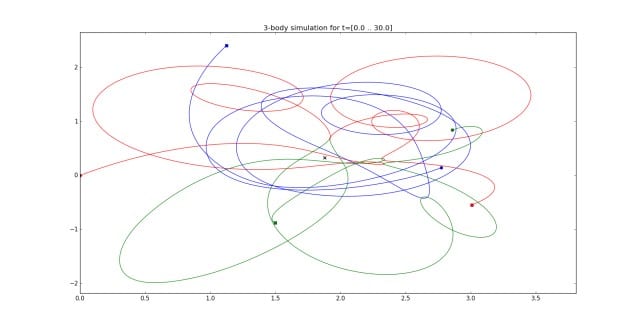
But a computer can. Not by using an algorithm, which is how biological brains — human and bee alike — evolved to make sense of the world, but by brute force calculations. Remember, you know everything about these three objects … none of the physics here is a mystery. If you can do the calculation quickly enough, you can compute where all three objects will be one second from now. And one second from then. And one second from then. And so on and so on. With enough processing power (and this can require a LOT of processing power) you can calculate where the three objects will be 100 years from now, even though it is impossible to solve for this outcome.
It’s a hard concept to wrap your head around, this difference between calculating the future and predicting the future, but it will change the way you see the world. And your place in it.
Now here’s an observation that I can’t emphasize strongly enough, although I’ll try:
THIS IS NOT HOW WE USE COMPUTERS IN OUR INVESTING STRATEGIES TODAY
The way that computers can calculate an answer to the Three-Body Problem is straightforward — they can be programmed with the physics rules for how one object influences another object, so they can simulate where each object will go next. There is ZERO examination of where the objects have been in the past. This is entirely forward looking.
The way that computers can NOT calculate an answer to the Three-Body Problem is by examining the historical data of where the objects have been. In a chaotic system, it doesn’t matter how hard or how fast or how deeply you look at the historical data. There is NO predictive pattern, NO secret algorithm hiding in the data. And yet this is exactly what we all have our computers doing … examining historical data to look for patterns that will give us the magic algorithm for predicting what’s next! The only thing that the past gives you in a chaotic system is inertia, which can look like a pattern or an algorithm for some period of time, depending on how all the objects are aligned. But it’s a mirage. It will not last. Examining the past of a chaotic system can give you lots of little answers, like sparks off a bonfire, none lasting more than a few seconds. And certainly if you’re efficient with your inertia-identifying spark-capturing effort, you can make some money using computers this way. But this examination of the past through naïve induction will never give you The Answer. Because The Answer does not exist in the past. The Answer — which is another word for algorithm, which is another word for “general closed-end solution” — doesn’t exist at all in a chaotic Three-Body System.
But we can approximate The Answer. We can calculate the future in small computational chunks even if we can’t predict the future in one big algorithmic swoop, but only if we can program the computer with the “physics” of how “gravity” works in social systems like markets. What’s our financial world equivalent of a theory of gravity? I think it’s a theory of Narrative. This, to me, is a more interesting research program than identifying small inertias or capturing brief sparks. But it’s not where our computing resources are being allocated, because there’s no money in it. Yet.
Exploring a theory of narrative, what I’ve called The Narrative Machine, is basic research. Like all basic research, it’s not immediately remunerative and thus is difficult to fund. But that’s not the biggest obstacle. No, the biggest obstacle to basic research in computational finance is that humans are hard-wired to look for algorithms and have a really hard time imagining that it’s even possible to pursue a non-anthropomorphic (how about that for a $10 word) research design that doesn’t pore through historical data looking for predictive algorithms at every turn. We can’t help ourselves!
What if I told you that algorithms and derivatives are as much at the heart of how humans prepare for their financial future as they are for bees preparing for their seasonal future? What if I told you that the dominant strategies for human discretionary investing are, without exception, algorithms and derivatives? And what if I told you that these algorithms and derivatives were perhaps “evolved” under a “benign” configuration of the Three-Body Problem that not only might never repeat, but in fact is certain to never repeat because it is a chaotic system?
I’ll give you two examples of influential investment algorithms/derivatives. There are many more.
GOOD COMPANIES => GOOD STOCKS
GOOD COUNTRIES => GOOD GOVERNMENT BONDS
These are the central tenets of stock-picking and sovereign bond-picking, respectively. In both cases, goodness (like beauty) is in the eye of the beholder, so I’m not saying that there is some single standard for what makes a “good” company or what makes a “good” set of macroeconomic policies. What I’m saying is that everyone reading this note (including me!) believes that there is a direct relationship between the quality of a company or an economy (however you define quality) and the future price of whatever stocks or bonds are connected to that company or economy. What I’m saying is that everyone reading this note believes that tracking the measurable quality of a company or an economy (the derivative) according to some standardized and repeatable process (the algorithm) will, over time, have a predictive correlation with the future price of the related stock and bond securities (the underlying).
What stocks do we want to own? Why, the stocks of high quality companies, of course … companies with stellar management teams, fortress balance sheets, and wonderful products or services that everyone wants to buy. Ditto for government bonds and currencies and broad market indices and the like. Maybe it will take some time for this faith in Quality to pay off, but we all believe that it WILL pay off. It’s only natural, right? As natural as spring following winter. As natural as flowers blooming in May and snow falling in December. Maybe the flowers will bloom a few weeks late and maybe the snows will fall a few weeks early, but that’s just basis risk, and we can manage for that.
But what if spring doesn’t follow winter anymore?
Look, I’m not asking us to abandon our faith in Quality. One of the key corrolaries of the Three-Body Problem is that we don’t have to reject our belief that Objects 1 and 2 exist. We don’t have to deny our faith that the Quality-of-Companies is an actual thing and that it has a big gravitational pull on the price of stocks. We don’t have to deny our faith that the Quality-of-Governments is an actual thing and that it has a big gravitational pull on the price of government bonds.

What we have to accept is that there is an Object 3 that has moved into a position such that its gravity absolutely swamps the impact of Objects 1 and 2. This Object 3, of course, is extraordinary monetary policy, specifically the purchase of $20 TRILLION worth of financial assets by the Big 4 central banks — the Fed, the ECB, the BOJ, and the PBOC.
$20 trillion is a lot of mass. $20 trillion is a lot of gravity.
Here’s the impact of all that gravity on the Quality-of-Companies derivative investment strategy.
The green line below is the S&P 500 index. The white line below is a Quality Index sponsored by Deutsche Bank. They look at 1,000 global large cap companies and evaluate them for return on equity, return on invested capital, and accounting accruals … quantifiable proxies for the most common ways that investors think about quality. Because the goal is to isolate the Quality factor, the index is long in equal amounts the top 20% of measured companies and short the bottom 20% (so market neutral), and has equal amounts invested long and short in the component sectors of the market (so sector neutral). The chart begins on March 9, 2009, when the Fed launched its first QE program.
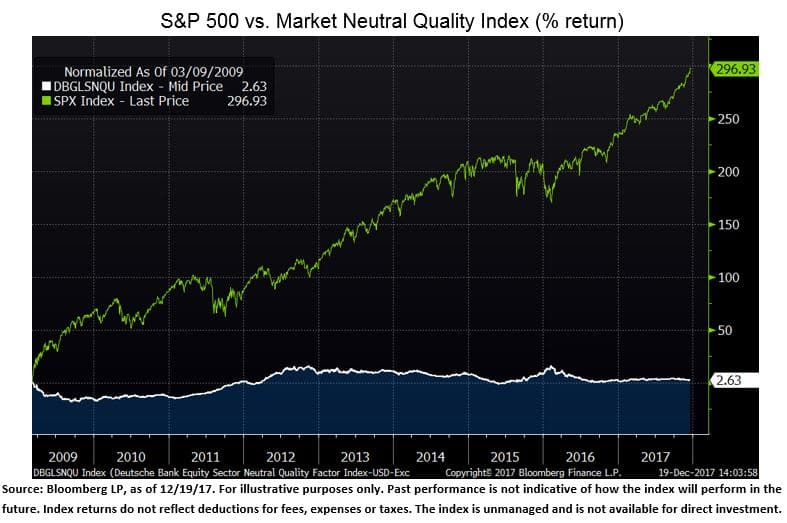
Over the past eight and a half years, Quality has been absolutely useless as an investment derivative. You’ve made a grand total of not quite 3% on your investment, while the S&P 500 is up almost 300%.
This is not a typo.
Have the Quality stocks in your portfolio gone up over the past eight and a half years? Sure, but it’s not because of the Quality-ness of the companies. It’s because ALL stocks have gone up ever since Object 3, the balance sheets of central banks, started exerting its massive gravity on everything BUT Quality. That’s not an accident, by the way. Central banks don’t care about rewarding “good” companies. In fact, if they care about anything on this dimension, they care about keeping “bad” companies from going under.
This is what it looks like when spring does not follow winter.
And here’s the impact of all that gravity on the Quality-of-Countries derivative investment strategy.
The gold line below is the spread (difference) between Portugal’s 10-year bond yield and the U.S. 10-year bond yield, and the blue line is the spread between Italy’s 10-year note yield and the U.S. equivalent. In “normal” times, a country with a weaker set of macroeconomic characteristics (high levels of national debt, say, or maybe low productivity) will have to offer investors a higher rate of interest to borrow their money than a country with a stronger set of macroeconomic characteristics. So in the summer of 2012, when Portugal and Italy were both looking like deadbeat countries, they had to pay investors a much higher rate of interest than the U.S. did to attract the investment … about 9% more (this is per year, mind you) for Portugal and 4% more for Italy. Those are enormous spreads in the world of sovereign debt!
This chart begins in the summer of 2012, when the ECB announced its intentions to prop up the European sovereign debt market directly. Since that announcement — even though both Portugal and Italy have higher debt-to-GDP ratios today than in 2012 — the spread versus U.S. interest rates has done nothing but decline. Driven by the commitment of the ECB to “do whatever it takes” and to be not only a last-resort buyer but also a first-in-line buyer of Portuguese and Italian debt, it now costs LESS for these countries to borrow money for 10 years than the U.S.
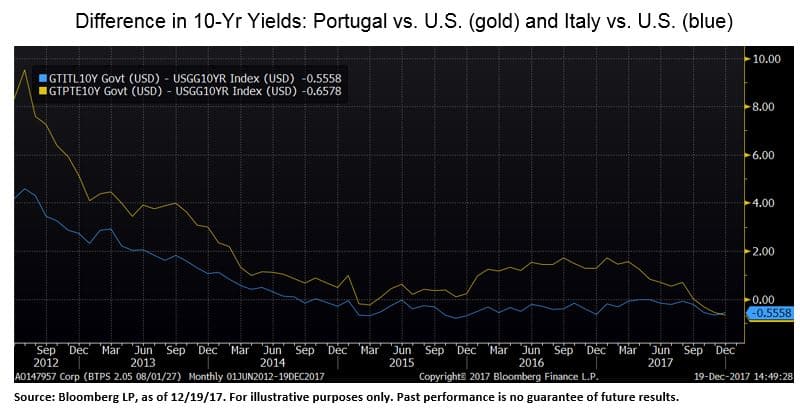
This is nuts. It’s an understandable nuts when you consider that the German 10-year bond yield is currently about 30 basis points, and was actually negative (meaning that you had to pay the German government for the privilege of lending them money for the next 10 years) for about six months in 2016. Meaning that at least with Italian and Portuguese debt you’re being paid something (a little less than 2% per year). It’s an understandable nuts when you consider that the Swiss 10-year bond still sports a negative interest rate and has been negative for the past two and a half years. There’s about $10 trillion worth of negative yielding sovereign bonds out there today, something that is IMPOSSIBLE under a [good country => good bond] derivative algorithm. No country is that good! But it’s entirely possible under the immense gravitational force of massive central bank asset purchases.
Here’s the kicker. Below is the spread between Greek 10-year sovereign bonds and U.S. 10-year notes. In 2012 you were paid 24% more to lend money to Greece. Per year! Today you are paid less than 2% more to lend money to Greece rather than the United States. For ten years. To Greece.
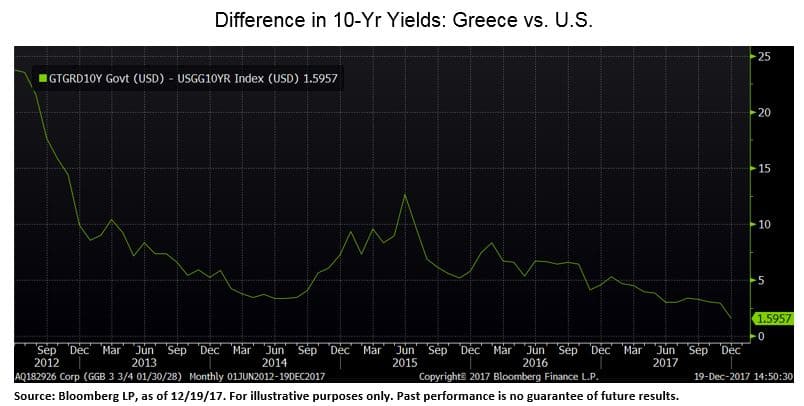
Again, I’m not saying that the Quality derivative doesn’t exist as a real thing or that it isn’t an important factor in the history of successful stock-picking or bond-picking. What I’m saying is that the Quality derivative hasn’t mattered for eight and a half years with stocks and five years with sovereign debt. What I’m saying is that it might not matter for another eighty years. Or it might matter again in eight months. A Three-Body System is a chaotic system. As the boilerplate says, past performance is not a guarantee of future results. In fact, the only thing I can promise you is that past performance will NEVER give you a predictive algorithm for future results in a chaotic system.
This is basis uncertainty. This is the biggest concern that every investor should have, that the signals (derivatives) and processes (algorithms) that we ALL use to make sense of the investing world are no longer connected to security prices.
… Okay, Ben, you’ve exhausted me. It’s a weird and strange way of looking at the world, but let’s go with it for a minute. What’s the pay-off here? What do we DO in a chaotic system? What does that even mean, to say that we are investors in a chaotic system?
Four suggestions.
First, I think we should adopt a philosophy of what I’ve called profound agnosticism when it comes to investing, where we don’t just embrace the notion that no one has a crystal ball in this system, but we actually get kinda annoyed with those who insist they do. I think that risk balancing strategies make a ton of sense in a chaotic system, so that we think first about budgeting our risk agnostically across geographies and asset classes and sectors, and secondarily think about budgeting our dollars.
Second, and relatedly, I think we should adopt a classic game theory strategy for dealing with uncertain systems — minimax regret. The idea is simple, but the implications profound: instead of seeking to maximize returns, we seek to minimize our maximum regret. Keep in mind that our maximum regret may not be ruinous loss! I know plenty of people whose maximum regret is not keeping up with the Joneses. In fact, from a business model perspective, that’s more common than not. Or if you’ve bought into Bitcoin north of $15,000 per coin, I think you know what I’m talking about, too. The point being that we need to be painfully honest with ourselves about our sources of regret and target our investments accordingly. If we can be this honest with ourselves, it’s a VERY powerful strategy.
Third, I think we should reconsider our approach to computer-directed investment strategies. Using computers in an anthropomorphic way, where we treat them like a smarter, faster human, set loose in a vast field of historical data to search for patterns and algorithms … it’s a snipe hunt. Or at least I think we’ve squeezed just about all the juice out of this inductive orange that we’re likely to get. With the massive processing power at our fingertips today, not to mention the orders-of-magnitude-greater processing power that quantum computing will bring to bear in the future, there’s much bigger game afoot with computational approaches that take a more deductive, forward-looking strategy.
Fourth, and perhaps most importantly, I think we need to accept that we’re never going to fully understand the reality of a chaotic system, but that it’s never been more important to try. The brains of both bees and humans are hard-wired for algorithms. Both species see patterns even when patterns don’t exist, and both species tend to do poorly in environments where derivative signals are plagued by basis uncertainty rather than mere basis risk. Every bee in the world will follow its hard-wired algorithms even unto death. And most humans will, too. But humans have the capacity to think beyond their biological and cultural programming … if they work at it.
Where do we lose good people? When they convince themselves that they’ve found The Answer — either in the form of a charismatic person or, more dangerously still, a charismatic idea — in a chaotic system where no Answer exists. A chaotic system like markets, yes, but also a chaotic system like politics.
The Answer is, by nature, totalitarian. Why? Because it’s a general closed-form solution. That’s the technical definition of The Answer, and that’s the practical definition of totalitarian thought. We’re hard-wired to want the all-encompassing algorithm, which is why it’s so difficult to resist. But if we care about liberty. If we care about justice. If we care about liberty and justice for all … we have to resist The Answer.
Because we’ve lost enough good people.
As wise as serpents, as harmless as doves …
PDF Download (Paid Subscription Required): http://www.epsilontheory.com/download/15775/







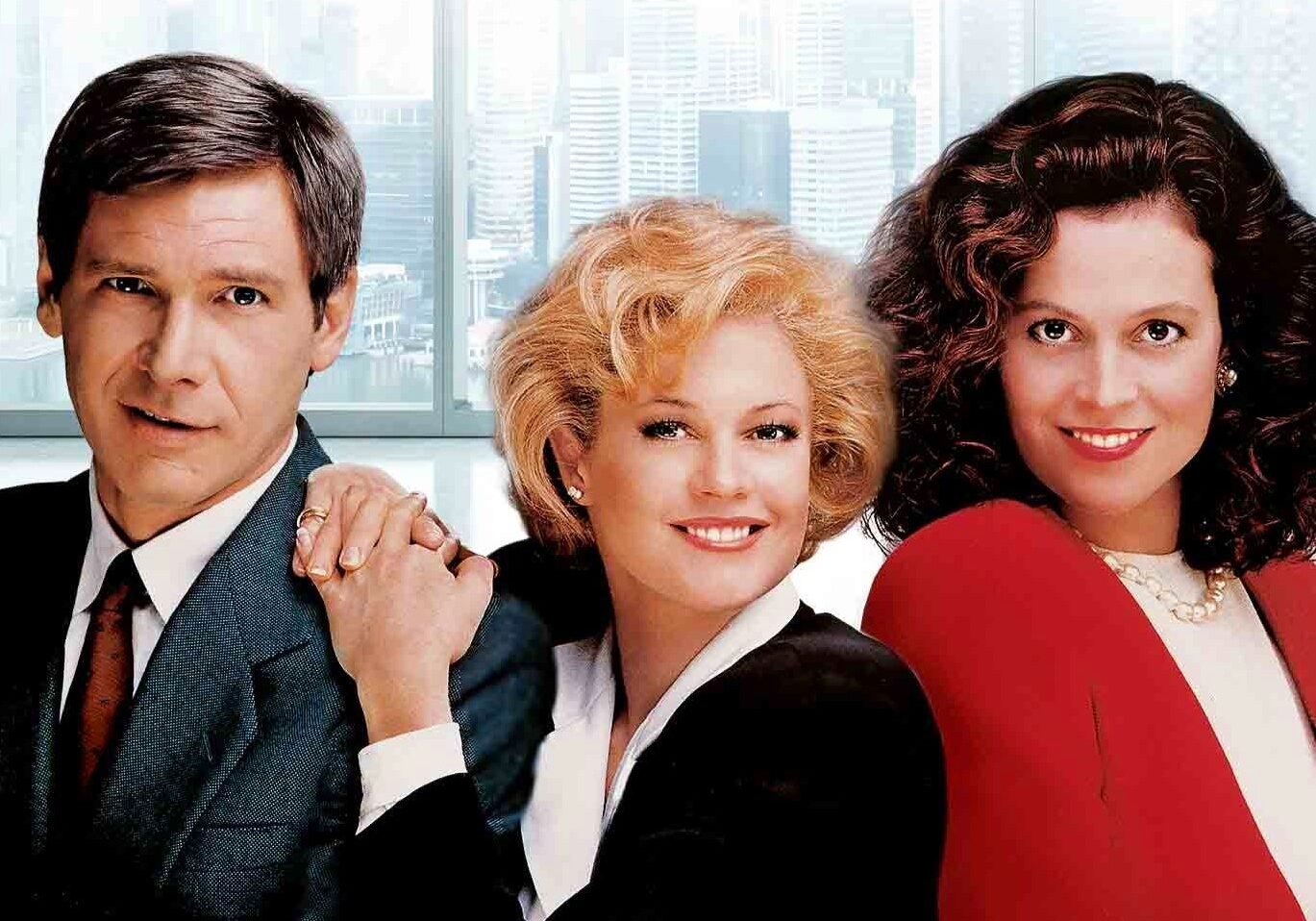




This is Excellent. Thank you ?
This note, and “Sheep Logic” are my two perenial favorites
They have been immensely clarifying.
Thank you Ben
The underlying assumption in economics - at least the way we were taught- is that money was a scarce commodity .
Have we now morphed into a society where that is no longer the case ?
& With that foundationaL assumption gone, is all econometrics = rubbish
I think Ben was correct to repost this …the markets make zero sense to me ,as I write this today Producer Prices were just announced up 8.6% YOY --and the 10 year Treasury yield is DOWN to 1.445%
I’ve read this note a few times since 2017. Each read hits me differently. Earlier this year I read The Three-Body Problem, great book. Why did today’s read strike a nerve? At the end of the note, “That’s the technical definition of The Answer, and that’s the practical definition of totalitarian thought.” I’ve brushed over the ending on my previous reads, but today “totalitarian thought” bothered me. Maybe that’s the point of BITFD, to avoid a totalitarian outcome?